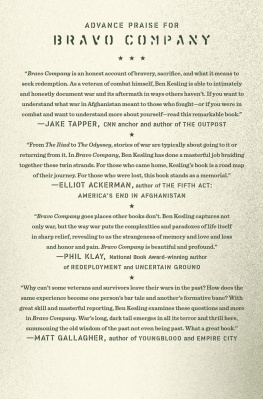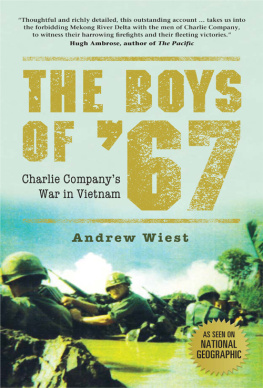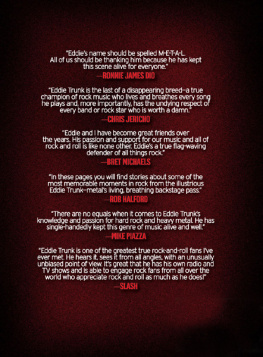Acknowledgments
AS with any project of this magnitude, it is impossible to thank all those who contributed. But a few deserve special mention.
First and foremost are the soldiers of Charlie Company, without whom none of this would have been possible. Their dedication to duty, professionalism as soldiers representing the United States, and combat skills and ability to adapt and improvise under fire made it possible for the entire company to complete the mission of getting to Baghdad, getting rid of Saddam Hussein, and returning home alive. 1st Sgt. Jose Mercado was the companys conscience and heart. He was also my right-hand man during the formation of Charlie Company at Fort Stewart, Georgia, during training in Kuwait, and through the war in Iraq. Without his experience and expertise the war would have been far more difficult than it was. He always had the best interests of the soldiers at heart and was the epitome of what a first sergeant should be.
The platoon leaders1st Lt. Roger Gruneisen, 1st Lt. Jeremy England, and 2nd Lt. Erik Balascikand their platoon sergeants were the keys to the success of Charlie Company during the war.
1st Lt. Shane Williams, Charlie Companys executive officer, handled many duties that were neither pleasant nor easy and was often the tail-end Charlie to make sure everyone got to where they were supposed to go.
The families of Charlie Company soldiers also were instrumental in our success during and after the major combat phase of the war for the manner in which they conducted themselves on the home front. A special thanks goes to my wife, Susan Conroy, who headed the company Family Readiness Group and answered frantic phone calls and e-mails at all hours of the day and night from wives, mothers, and members of the media. And a special thank-you goes to Ashlie and Amanda Conroy, for their help and their love.
Col. David Perkins of the 2nd Brigade Combat Team Spartans was daring and insightful as a combat commander. He also saw the value of having embedded media with the brigade, which made the telling of this story possible.
Lt. Col. Rick Schwartz, Maj. Rick Nussio, Maj. Mike Donovan, Capt. Joe Linn, and the command staff of Task Force 1-64, the Desert Rogues, provided the leadership necessary for soldiers to conduct successful combat operations in Iraq. They also opened up their tactical operations center so the media could get a full and uncompromising view of American soldiers at war on the 21st century battlefield.
Col. Rick Thomas and the public affairs staff at the Combined Forces Land Component Command helped pave the way for embedded media within the 3rd Infantry Division and throughout the theaterwithout them this story could not have been told.
Lt. Col. Mike Birmingham and M. Sgt. Emma Krouser of the 3rd Infantry Divisions public affairs staff helped make the embed system work during the war and in the sometimes chaotic aftermath.
Lt. Col. Peter Bayer, the division G-3, provided valuable insights about the planning process before and during the war, as well as an overview of events as they unfolded outside of the very narrow scope of Charlie Company operations. He also read portions of the manuscript and provided comments and suggestions to help ensure historical and technical accuracy.
Sgt. 1st Class Brett Waterhouse made his detailed diaries available and they proved to be valuable in making sense of occasional confusing timing of key events. His no-nonsense leadership and sense of rightness also was a valuable resource for Charlie Companys first platoon.
S.Sgt. Jabari Williams, Charlie Companys master gunner, was a font of knowledge about the characteristics of 120mm rounds and the maneuver schemes and formations in tank warfare.
John Glenn, photo editor of the Atlanta Journal-Constitution, was instrumental in securing most of the photographs taken by Brant Sanderlin that are an important part of this book. Those photos chronicled Charlie Companys successes and heartaches and will help the reader better understand just what the soldiers endured.
On relatively short notice, Dale Dodson drew the maps and graphics that give the necessary detail to explain Charlie Companys movement into Iraq and later into downtown Baghdad as part of Task Force 1-64 and the 2nd Brigade Combat Team.
Julia Wallace and Hank Klibanoff opened up the photo and news archives of the Atlanta Journal-Constitution and were of great assistance in getting this project completed. They also were an invaluable source of moral support during and after the war.
Don McKeon at Brasseys, Inc., saw the merit in a book about a single tank company even while Charlie Company was still in Iraq, provided encouragement when needed, and a kick in the pants when needed.
Lloyd M. Burchette, Jr., supplied key research throughout the project, often responding on just a few moments notice to requests for detailed technical information about various weapons systems and events that occurred far from Charlie Companys area of operations. This book never could have been written without his assistance, wise counsel, and insightful knowledge of military affairs, which he freely dispensed during the research and writing of this book.
I would be remiss without making special mention of Brant Sanderlin, the photographer from the Atlanta Journal-Constitution, who accompanied Charlie Company during the war. Often at the risk of his own life, he took photos that provided a gripping portrait of one tank companys battle to Baghdad. His work appeared in publications all over the world and gave many people a true picture of what combat is really like for soldiers on the front lines. He also was a much-needed link between soldiers and families not only with his photos, but with his satellite telephone, which helped soldiers communicate with their families.
If there are errors in this work, they are unintentional. In the end, though, credit for all that is right in this book goes to the soldiers of Charlie Company.
Appendix: Charlie Company Vehicle Assignments and Roster
Authors note: The following does not reflect permanent crew assignments throughout the war. Loaders and drivers swapped tanks frequently depending on mechanical problems or needs at any particular time. The number of soldiers here, seventy-nine, includes several who joined Charlie Company during and shortly after the war.
M1A1 Abrams
First Platoon (Red)
Charlie One-One (Red One)
Creeping Death/Cruel Intentions
1st Lt. Roger Gruneisen (tank commander, platoon leader)
Sgt. Carlos Hernandez (gunner)
Spc. Donald Schafer (loader)
Spc. Derek Peterson (driver)
Charlie One-Two (Red Two)
Cojone, Eh?
S.Sgt. Jason Diaz (tank commander)
Sgt. Jose Couvertier (gunner)
Pfc. Fausto Trivino (loader)
Pfc. Chris Shipley (driver)
Charlie One-Three (Red Three)
Call Yo Chaplain
S.Sgt. Larrico Alexander (tank commander)
Sgt. Sidney Dorsey (gunner)
Psc. Jose Campos (loader)
Spc. Tony Lyman (driver)
Charlie One-Four (Red Four)
Crazy Horse
Sgt. 1st Class Brett Waterhouse (tank commander)
Sgt. Phillip Riley (gunner)
Spc. Brian Jasper (loader)
Pfc. Travis Jones (driver)
Second Platoon (White)
Charlie Two-One (White One)
California Dreamin
1st Lt. Jeremy England (tank commander, platoon leader)
Sgt. Chris Freeman (gunner)
Spc. Mark Gatlin (loader)
Pfc. K.C. Brons (driver)
Charlie Two-Two (White Two)
Columbia 2
S.Sgt. Randy Pinkston (tank commander)
Sgt. Scott Stewart (gunner)
Pfc. Artemio Lopez-Martinez (loader)
Pfc. Justin Mayes (driver)
Charlie Two-Three (White Three)









